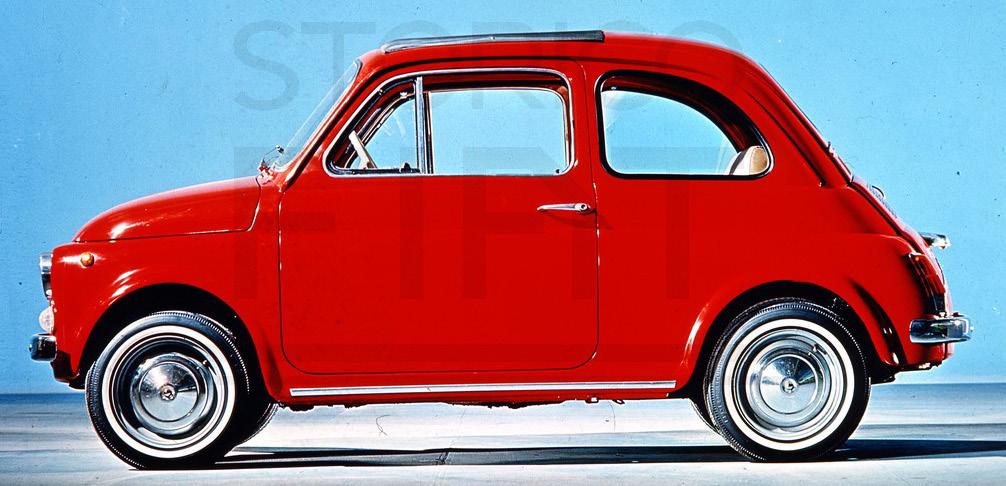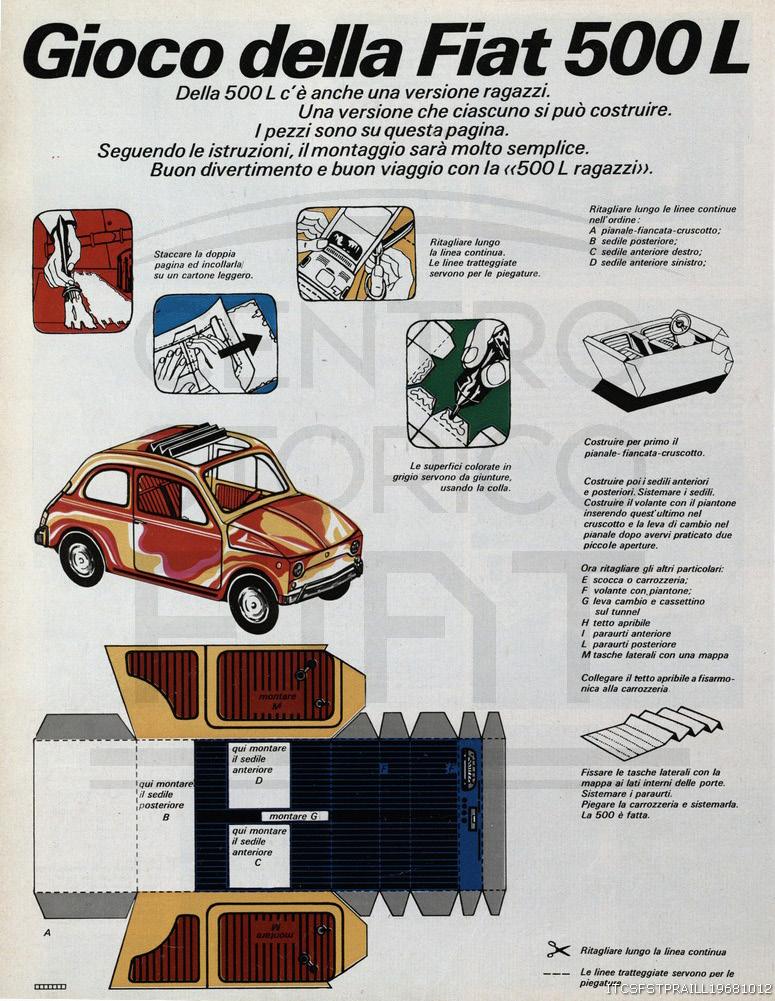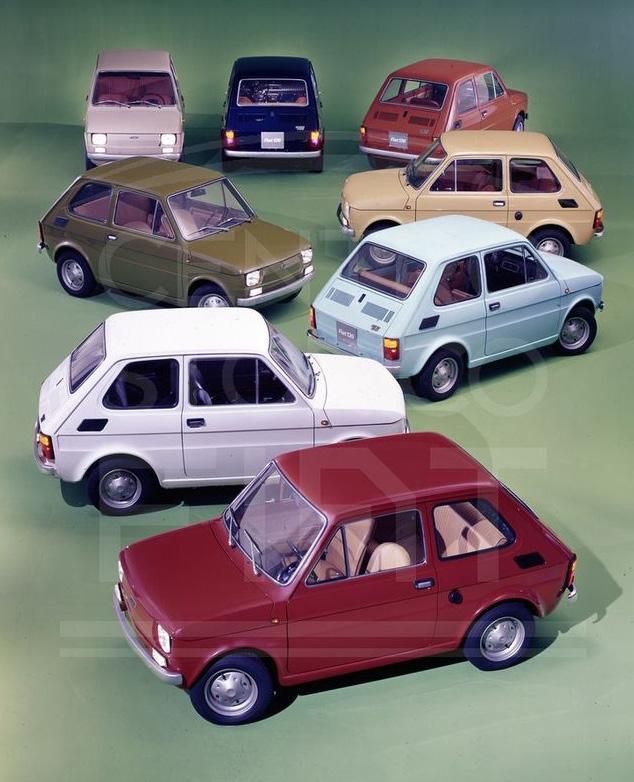

The 500 before the 500: the Topolino 6
The birth of a pop icon 44
Success without fame: 126, Cinquecento and Seicento 100
The birth of a brand: the 500, from the 2007 model on 100
The 500s as Masterpieces 200
 Introduction 4
Introduction 4


Contents


An advertising illustration of the 500 sedan and the van, a model introduced in 1936. It was not until after the war that the Giardiniera arrived.
21
20-21

48
48-49 Quality control and approval of the Nuova 500 at the end of the assembly line in the Mirafiori factory in Turin. The nearby lines produced the 600, the 1100/103, and the 1400/1900.
49 Presentation of the Nuova 500 at a Fiat dealership. The stork was probably the work of Aerostudio Borghi, who had proposed a similar one to Lancia.


Giacosa wanted a vertical-twin-cylinder air-cooled engine, made with an aluminum crankcase and separate cast-iron pipes, a camshaft in the crankcase with rods and rocker arms and intake manifolds produced when the head was cast. A rear, longitudinal 479 cc engine was suspended on the chassis with a pantograph to absorb vibrations, cooled by a fan, coaxial with the dynamo, which circulated air inside the fairing that encapsulated it. An issue of space made it necessary to develop a centrifugal oil filter, which turned out to be so efficient that it was also used in many other Fiats. The differential and the non-synchronous four-speed transmission with synchromesh, which required double-clutching during the downshift, were one block. The engine was designed by Giovanni Torazza, the transmission by Angelo Mosso. The independent front axle had telescopic shock absorbers and transverse leaf springs, while the rear axle had swing-arm suspension and coil springs. The car had hydraulic drum brakes.
In 1954, the director of the automotive design department, Giuseppe Alberti, prepared a model that utilized many of the 600’s car body parts and one inspired by Bauhof’s prototype, with the front end a little bit higher on the beltline. The second model was chosen; it was an essential, no-frills product, typical of Italian industrial design. So that it would not become competition for the 600, the sales and marketing director decided to make it a 2+2, with two front seats and two makeshift seats in the back, and decreased the engine size by a couple of HP. Both were errors that would be corrected during the vehicle’s first years on the market.
49
one million city cars: 500 F (1965-1972)
The 1965 500 F introduced a reinforced clutch, differential, and axle shaft. The Highway Code had begun to prohibit the so-called “suicide”—or rear-hinged—doors that were considered a possible cause of accidents. The new doors opened against the wind, and the hinges were recessed. The F abandoned the bolted roof of the Sunroof version in favor of one molded with the pillars, with a curvature that further improved interior comfort. The only metal body parts that remained the same as the D were the hood and the rear transom; everything else was redesigned, albeit imperceptibly.
The molding halfway up the side was eliminated, but the one on the doorsill remained. The engine (type 110F.000) had reinforced exhaust manifold connections, valves with double return springs, and a PCV valve in the tappet lid, which was made of pressed—no longer cast— metal. In the first ten months of production, four bolts per side were used to fix the recessed hinges to the body, rather than the two bolts that would be used in later models—and in fact, the models produced in 1965–1966 (vehicle identification numbers up to one million, approximately) are fondly called “eight bolts” by buffs.


70



70-71 Side view of the 500 F. Although almost all its body panels were redesigned, the only obvious difference from the D was the curve of its roof.
71 A cutaway drawing of the mechanics of the 500 F. In 1966, with the F, production run of the 500 “tipo 110” reached one million units.
71


76 and 77 From the time of the Balilla, particularly in the postwar period, the companies in the Fiat group took very good care of their young fans, with mass-produced inexpensive gadgets. This paper car dedicated to the 500 L was published in a weekly newspaper. Since the paper was light, the instructions advised the user to reinforce it by to cutting it out and gluing it to a piece of cardboard.
77
SQUARE-SHAPED SIMPLICITY: the 126 I SERIES (1972-1977)


The mechanics of the Italian and Polish versions were identical, based on the evolution of the 500 engine that reached 594 cc and delivered 16kW/23 HP; its gearbox remained a 4-speed, but it was synchronized. The gas tank was moved from the trunk in the front to the back, for safety reasons, and although the wheelbase remained the same as its precursor, the body was bigger. Only one trim package and one engine were available but there were two options for the roof, which could be completely closed or with a sunroof that opened above the front seat, like the roof of the 1959 500. In September 1975, the Tychy factory joined the Bielsko-Biała factory, both of which were located in the Silesia region, in Polish production. Four FSM versions were made in that period: the 126p 600 (standard model), the 600S (special version), the 600K (Comfort), and the 600I (outfitted for disabled drivers). In Austria, the heir to the 500 Steyr-Puch was a 126 made with bodies sent
from Cassino, which were completed with Steyr axles and a 25 HP 643 cc two-cylinder boxer. Production lasted for two years.
The 126 got its first restyling in November 1976, which meant three versions for Western Europe. The Base kept the chrome bumpers from the first series; the Personal had an upgraded interior that included a dashboard covered in carpet that would later be replaced with imitation leather, but a rather austere back bench; and the Personal 4 was identical to the Personal, but with a padded back seat. The Personal was called the De Ville in Great Britain and the Bambino in Germany. All of the versions had an alternator instead of a dynamo, new wheels with black plastic hubcaps, and 40 rather than 48 air vents in the hood. The space for the license plate was changed from vertical to horizontal to accommodate the new shapes of the plates that were being issued in the European Economic Community at the time.

102
102 The cassino first series had orange indicator lights and still had the chrome bumpers that were used in Poland on some versions until the late 1980s.
103 The range of colors of the 126 first series had some colors in common with the 500 R. The closed-roof version was the most widely requested in Italy.

THE STARS AS A ROOF: 500 C I SERIES (2009-2015)

The 500 C (the C stands for cabriolet) was presented at the Geneva Motor Show in 2009. It reintroduced the concept of the 1957 Nuova 500, with a fabric sunroof that opened all the way to the trunk while keeping its pillars and doorframes. The electrically powered top and its glass rear window fold down into the parcel
shelf so the car’s trunk space is almost the same as that of the sedan, 6.4 cubic feet (182 l) instead of 6.5 cubic feet (185 l). The Lounge was originally the basic version, sold alongside the sportier Rock with low-profile tires. The following year, a simpler and more economical version, the Pop, completed the series.
142 The 500C with its top up. It was initially proposed with the same trim package as that of the top versions of the sedan. The less-expensive Pop came out later.
143 A view of the apex of the top as it opens. Since the top did not fold down into the trunk, the trunk retained the same capacity as that of the sedan.
142


143

204 The 500 in Nico Edel’s illustration seems to be deformed by speed, an inspiration that futurists loved but that today is difficult to relate to the 500’s mediocre performance. In the Italy of the 1930s, simply having a motor would give your life a burst of speed it had never had before.
204
205 Another streamlined 500 by Edel, with its headlights curiously mounted on the fender arches, like on Giacosa’s second prototype. Portraying the Topolino with a businessman who used it to travel for work perfectly conveyed the spirit of the utility car that it was designed to be.

Project Editor VALERIA MANFERTO DE FABIANIS
Editorial assistants GIORGIA RAINERI and GIORGIO FERRERO
Graphic Designer PAOLA PIACCO
WS White Star Publishers® is a registered trademark property of White Star s.r.l.
© 2020 White Star s.r.l.
Piazzale Luigi Cadorna, 6 20123 Milan, Italy www.whitestar.it
All rights reserved. No part of this publication may be reproduced, stored in a retrieval system, or transmitted in any form or by any means, electronic, mechanical, photocopying, recording, or otherwise, without written permission from the publisher.
ISBN 978-88-544-????-?
Printed in ???
1 2 3 4 5 6 24 23 22 21 20


 Introduction 4
Introduction 4



















